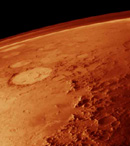| Diameter | 6794 km |
| Mass | 6,42*10^23 kg |
| Density | 3930 kg/m^3 |
| The period of rotation | 24 h 37 min |
| The average distance from the Sun | 1,52 ŗ.i. |
| The period of revolution | 686,98 years |
| Excentricity of the orbit | 0,093 |
| The orbitís slope | 1,85į |

Mars without inhabitants.
Mars is the fourth from the Sun big planet of the Solar system.
The equatorial radius of the planet is about 3394 km, the pole - 3376,4 km. The surface level in the south semisphere is 3-4 km higher than in the north.
Mars is in the minimal distance from the Earth during the oppositions, with the interval of 779,94 terrestrial days. Once a 15 - 17 years occures so-called the great opposition when the planets come nearer about 56 billions km. The last one was in 1988. During the great oppositions Mars is the brightest star in the night sky (-2,7 of the star value).
It is orange and red, tha's why it is considered to be a symbol of the war God.
The new level of Mars investigation began in 1965 when the spaceships were used to fly round the Mars and from 1971 landed on the planet.
The surface relief.
The telescopic investigations of Mars showed such peculiarities as the season changings on it. This is true to the "white pole hats", which smelts with the coming of spring.
 The great part of the Mars surface is the light part (continents) which has an
orange and red colour; 25% of the surface are more dark - the seas of grey and green
colour, the level of which is lower than the continents'. The owerfalles are great
and form 14 - 16 km in equator, but there are mountains,for example Arsija (26 km) and Olimp (27 Íž).
The great part of the Mars surface is the light part (continents) which has an
orange and red colour; 25% of the surface are more dark - the seas of grey and green
colour, the level of which is lower than the continents'. The owerfalles are great
and form 14 - 16 km in equator, but there are mountains,for example Arsija (26 km) and Olimp (27 Íž).
The investigations of Mars showes the traces of vulcanization on this planet: the splits and rawins sometimes hundred kilometers long. One of them stretches for 4000 km, its width is 120 km and its deapth is 4 - 5 km.
The hope to find the "human mind brothers" arises when A. Seccy and D. Skiparelli in 1887 formed a theory about Mars's channels, made by the rational being. These channels were supposed to be filled regularly with the water. But the next investigations of Mars don't prove this theory. The surface of Mars is a waterless and lifeness desert, covered with spray. There are great storms on Mars and the speed of the wind is about several tens kilometres in a second.
Mars's atmosphere and the water.
 The atmosphere
on Mars is rarefied (the pressure is hundred and even thousand part of atmosphere) and
consist of carbon dioxide (95%) and small addings of nitrogen (3%), argon (1,5%) and
oxygen (0,15%). The stream consentration is small but not stable.
The atmosphere
on Mars is rarefied (the pressure is hundred and even thousand part of atmosphere) and
consist of carbon dioxide (95%) and small addings of nitrogen (3%), argon (1,5%) and
oxygen (0,15%). The stream consentration is small but not stable.
It is considered that there is a lot of water in the Mars. The long valey system looking like the dry river bed or channels proves this theory. But where is now Mars water?
It is an idea that the water exists now in the eternal frost. The temperature on the Mars surface is about 220 K in the middle latitude and only 150 K in the poles. The water on the surface of Mars freeze and later is covered with the sand. So perhaps there are underground rivers on Mars.
The composition and the internal structure.
The chemical composition is typical to the planets of the terristrial groups, nevertheless there are some differs. The Mars core is rich with iron and sulphur and is small (its radius is 800 - 1000 km). The nucleus of Mars was being forming for 1 billion years, during the period of early vulcanization. And now step-by-step the planet is cooling.
The Mars cloak contains sulphuric iron. The thickness of Mars litosphere is several hundred kilometres.
The Mars satellites.
The two Mars satellites are Phobos (Fear) and Daimos (Harror). They have irregular form and always turn to Mars one and the Same side. Their maximum sizees: 26 km in the length and 21 km in the width (Phobos) and 13 km and 12 km (daimos). The gravitational fields are so weak that these satellites have no atmosphere.